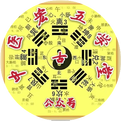
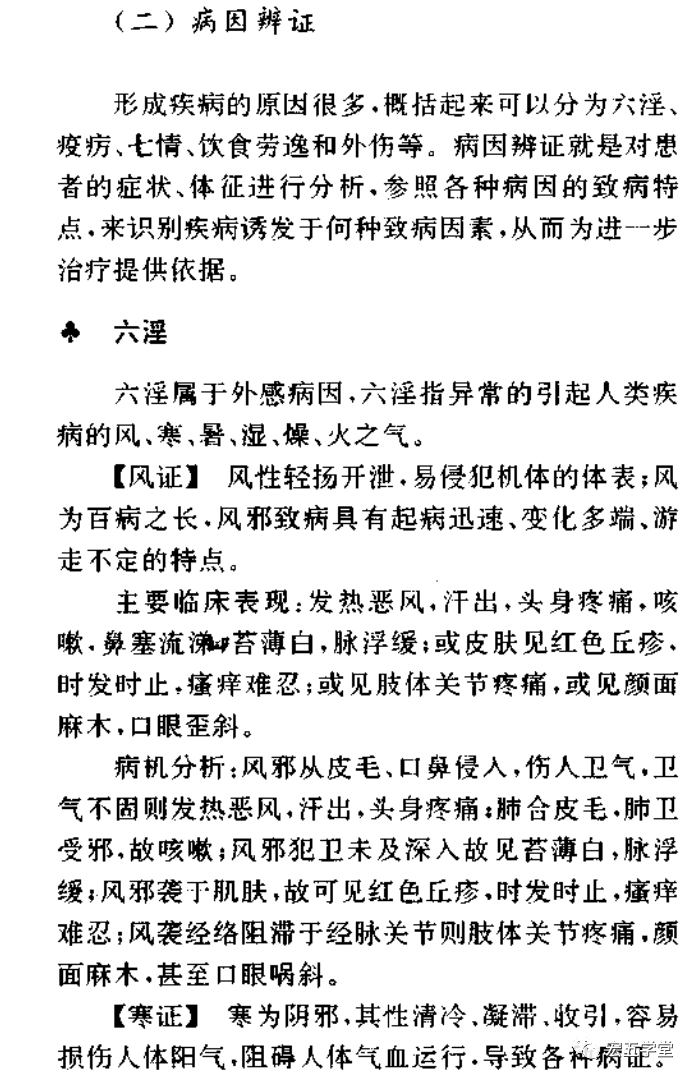
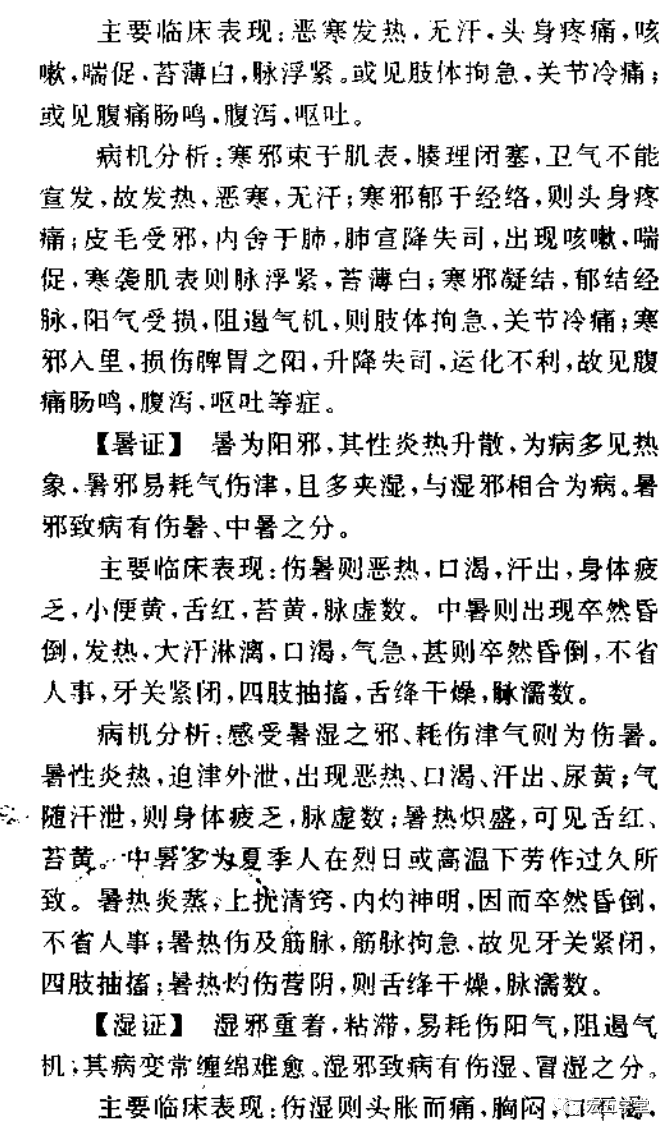
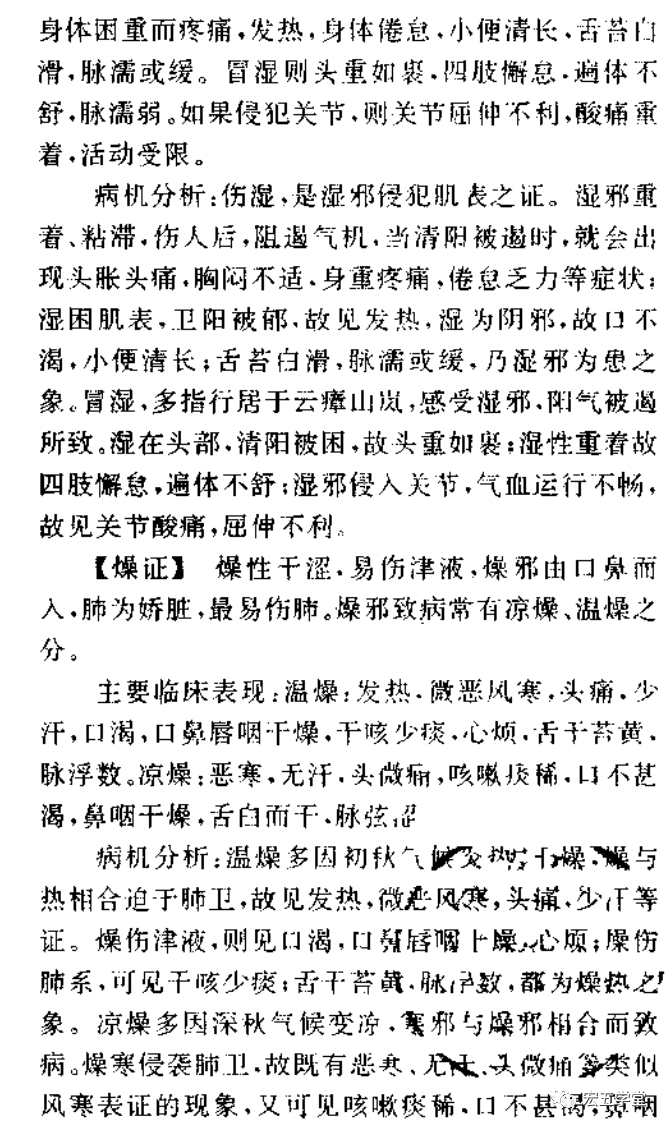
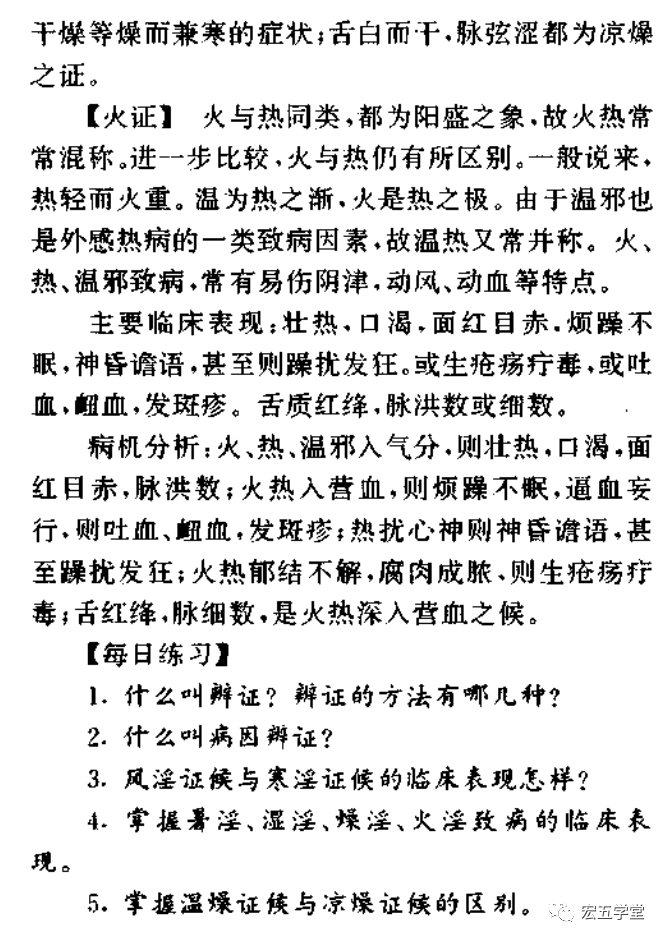
II. Etiological Diagnosis
There are many causes of disease, which can be broadly categorized into the Six Excesses (Liù Yín), epidemic factors, emotional disturbances, dietary habits, and external injuries. Etiological diagnosis involves analyzing the patient’s symptoms and signs. By referencing the pathogenic characteristics of various etiological factors, we can identify which pathogenic factor has triggered the disease, thus providing a basis for further treatment.
Six Excesses
The Six Excesses are external pathogenic factors, referring to the abnormal influences of wind (Fēng), cold (Hán), heat (Shǔ), dampness (Shī), dryness (Zào), and fire (Huǒ) that can cause diseases in humans.
[Wind Syndrome]Wind is light and dispersive, easily invading the body’s surface; it is known as the leader of all diseases. Wind pathogens are characterized by rapid onset, variable symptoms, and erratic movement.
Main Clinical Manifestations:Fever with aversion to wind, sweating, pain in the head and body, cough, nasal congestion with runny nose, thin white tongue coating, floating and slow pulse; or red papules on the skin that appear and disappear intermittently, causing unbearable itching; or joint pain in the limbs, or facial numbness with deviation of the mouth and eyes.
Pathogenesis Analysis:The wind pathogen invades through the skin and nose, damaging the defensive qi (Wei Qi). When Wei Qi is not secure, it leads to fever and aversion to wind, sweating, and pain in the head and body; the lungs, which are associated with the skin, are affected, resulting in cough; since the wind pathogen has not deeply invaded, the tongue coating remains thin and white, and the pulse is floating and slow; when the wind invades the skin, it can cause red papules that appear and disappear, leading to unbearable itching; if the wind obstructs the meridians, it can cause joint pain and facial numbness, even leading to deviation of the mouth and eyes.
[Cold Syndrome]Cold is a yin pathogen, characterized by its cold and constricting nature, which can easily damage the body’s yang qi and obstruct the flow of qi and blood, leading to various diseases.
Main Clinical Manifestations:Aversion to cold with fever, no sweating, pain in the head and body, cough, wheezing, thin white tongue coating, floating and tight pulse; or rigidity and cold pain in the limbs; or abdominal pain with borborygmus, diarrhea, and vomiting.
Pathogenesis Analysis:The cold pathogen constricts the exterior, causing obstruction, and the defensive qi cannot disperse, leading to fever, aversion to cold, and no sweating; when the cold pathogen stagnates in the meridians, it causes pain in the head and body; when the skin is affected, it can damage the lungs, leading to cough and wheezing; the cold pathogen invading the exterior results in a floating and tight pulse with a thin white tongue coating; when the cold pathogen obstructs the meridians, it damages the yang qi, causing rigidity and cold pain in the limbs; if the cold pathogen enters the interior, it can damage the spleen and stomach yang, leading to abdominal pain, borborygmus, diarrhea, and vomiting.
[Heat Syndrome]Heat is a yang pathogen, characterized by its hot and dispersive nature, often presenting with heat symptoms. Heat pathogens can easily consume qi and injure fluids, and they often combine with dampness to cause disease. Heat pathogens can lead to heat stroke or heat injury.
Main Clinical Manifestations:Heat injury presents with aversion to heat, thirst, sweating, fatigue, yellow urine, red tongue, yellow tongue coating, and a rapid pulse. Heat stroke can lead to sudden fainting, fever, profuse sweating, thirst, shortness of breath, and in severe cases, sudden fainting, loss of consciousness, clenched teeth, convulsions, and a dry red tongue with a rapid pulse.
Pathogenesis Analysis:Injury from heat and dampness leads to the consumption of fluids, resulting in aversion to heat, thirst, sweating, and yellow urine; fatigue occurs as qi is lost through sweating, leading to a rapid pulse; heat can cause a red tongue and yellow coating. Heat stroke is often caused by prolonged exposure to high temperatures or strenuous activity in hot weather. Heat can disturb the mind, leading to sudden fainting and loss of consciousness; it can also cause convulsions and a dry red tongue with a rapid pulse.
[Dampness Syndrome]Dampness is heavy and sticky, easily consuming yang qi and obstructing the flow of qi; its pathological changes are often chronic and difficult to resolve. Dampness can lead to damp injury or damp invasion.
Main Clinical Manifestations:Damp injury presents with a heavy and painful head, chest tightness, no thirst, heavy and painful body, fever, fatigue, and clear long urine. The pulse is slippery or slow. Damp invasion presents with a heavy head, fatigue in the limbs, and discomfort throughout the body, with a weak pulse. If it invades the joints, it can lead to limited movement and heavy, painful joints.
Pathogenesis Analysis:Damp injury occurs when dampness invades the exterior. The heavy and sticky nature of dampness obstructs the flow of qi, leading to symptoms such as heavy head, chest tightness, and discomfort. Dampness can also cause fever and fatigue; as it is a yin pathogen, it leads to no thirst and clear long urine. The tongue coating is white and slippery, and the pulse is slow or weak. Damp invasion often occurs in humid environments, leading to symptoms of heaviness and discomfort throughout the body; if it invades the joints, it can cause pain and limited movement.
[Dryness Syndrome]Dryness is characterized by its dry and astringent nature. It can easily injure body fluids, and dryness often enters through the mouth and nose. The lungs are particularly vulnerable to dryness. Dryness can be classified into warm dryness and cool dryness.
Main Clinical Manifestations:Warm dryness presents with fever, slight aversion to wind and cold, headache, little sweating, thirst, and dryness of the mouth, nose, and throat. There may be little sputum and irritability. The tongue coating is yellow, and the pulse is floating and rapid. Cool dryness presents with aversion to cold, no sweating, slight headache, cough with thin sputum, little thirst, dryness of the nose and throat, a dry white tongue, and a wiry pulse.
Pathogenesis Analysis:Warm dryness is often caused by initial dry weather. When dryness combines with heat, it can invade the lungs, leading to symptoms such as fever, slight aversion to wind and cold, headache, and little sweating. Dryness injures body fluids, leading to thirst and dryness of the throat; the tongue may be yellow, and the pulse rapid. Cool dryness is often caused by late autumn weather, where cold and dry conditions combine to cause disease. Cool dryness can invade the lungs, leading to symptoms similar to wind-cold, but with dry cough and little thirst; the tongue is dry and white, and the pulse is wiry.
[Fire Syndrome]Fire and heat are similar, both representing excess yang. Fire is often considered more severe than heat. Generally, heat is lighter while fire is more intense. Warm pathogens are also a type of external heat disease, and thus warm heat is often mentioned together. Fire, heat, and warm pathogens can easily injure yin fluids and provoke wind and blood movement.
Main Clinical Manifestations:High fever, thirst, red face and eyes, irritability, insomnia, confusion, and in severe cases, agitation and madness. There may be sores, bleeding, or rashes. The tongue is red, and the pulse is rapid or thin.
Pathogenesis Analysis:Fire, heat, and warm pathogens enter the qi level, leading to high fever, thirst, red face and eyes, and a rapid pulse; when fire and heat enter the blood level, they can cause irritability and bleeding; heat can disturb the mind, leading to confusion and agitation; if fire and heat accumulate, they can lead to sores and abscesses; the tongue is red, and the pulse is thin and rapid, indicating deep fire and heat in the blood.
Daily Practice:
1. What is the meaning of differentiation? What are the methods of differentiation?
2. What is etiological differentiation?
3. What are the clinical manifestations of wind syndrome and cold syndrome?
4. Understand the clinical manifestations of heat, dampness, dryness, and fire syndromes.
5. Understand the differences between warm dryness and cool dryness syndromes.

Link Review
《百日学中医诊断》1.1 TCM Diagnosis and Its Main Content
《百日学中医诊断》1.2 The Importance of Learning TCM Diagnosis
《百日学中医诊断》1.3 Characteristics and Principles of TCM Diagnosis
《百日学中医诊断》1.4 Methods of Learning TCM Diagnosis
《百日学中医诊断》1.5 One of the Four Examinations: Observation①【Observing Spirit】
《百日学中医诊断》1.5 One of the Four Examinations: Observation②【Observing Complexion】
《百日学中医诊断》1.5 One of the Four Examinations: Observation③【Common Colors and Disease Colors】
《百日学中医诊断》1.6 One of the Four Examinations: Observation④【Observing Form and Posture】
《百日学中医诊断》1.6 One of the Four Examinations: Observation⑤【Observing Five Organs】
《百日学中医诊断》1.6 One of the Four Examinations: Observation⑥【Observing Skin】
《百日学中医诊断》1.6 One of the Four Examinations: Observation⑦【Observing Meridians】
《百日学中医诊断》1.7 One of the Four Examinations: Observation⑧【Observing Tongue】
《百日学中医诊断》1.7 One of the Four Examinations: Observation⑨【Observing Tongue Points and Tongue Diseases】
《百日学中医诊断》1.8 Weekly Content Review
《百日学中医诊断》2.1. Olfactory Diagnosis: Hearing Sounds
《百日学中医诊断》2.2. Olfactory Diagnosis: Smelling Odors
《百日学中医诊断》2.3. Inquiry Diagnosis
《百日学中医诊断》2.4. Inquiry Diagnosis
《百日学中医诊断》2.4.2. Inquiry Diagnosis
《百日学中医诊断》2.5.1. Pulse Diagnosis Methods
《百日学中医诊断》2.5.2. Pulse Diagnosis Methods
《百日学中医诊断》2.6.1. Pulse Diagnosis Methods
《百日学中医诊断》2.6.2. Pulse Patterns and Variations
《百日学中医诊断》2.7.1. Second Week Review
《百日学中医诊断》2.7.2. Second Week Review
《百日学中医诊断》3.1.1. Eight Principles
《百日学中医诊断》3.1.2. Eight Principles【Exterior and Interior Syndromes】
《百日学中医诊断》3.2.1. Eight Principles【Cold and Heat Syndromes】
《百日学中医诊断》3.2.2. Eight Principles【Relationship Between Cold and Heat Syndromes】
《百日学中医诊断》3.3.1. Eight Principles【Deficiency and Excess Syndromes】
《百日学中医诊断》3.3.2. Eight Principles【Relationship Between Deficiency and Excess】
《百日学中医诊断》3.4.1. Eight Principles【Relationship Between Cold, Heat, Exterior, Interior, Deficiency, and Excess】
《百日学中医诊断》3.4.2. Eight Principles【Relationship Between Cold, Heat, Exterior, Interior, Deficiency, and Excess】
《百日学中医诊断》3.4.3. Eight Principles【Relationship Between Cold, Heat, Exterior, Interior, Deficiency, and Excess】
《百日学中医诊断》3.5.1. Eight Principles【Yin and Yang Syndromes】
《百日学中医诊断》3.5.2. Eight Principles【Differentiation of Yin and Yang Syndromes】
《百日学中医诊断》3.6.1. Eight Principles【Review】
《百日学中医诊断》3.6.2. Eight Principles【Review】
《百日学中医诊断》4.1.1. Differentiation【What is Differentiation】

